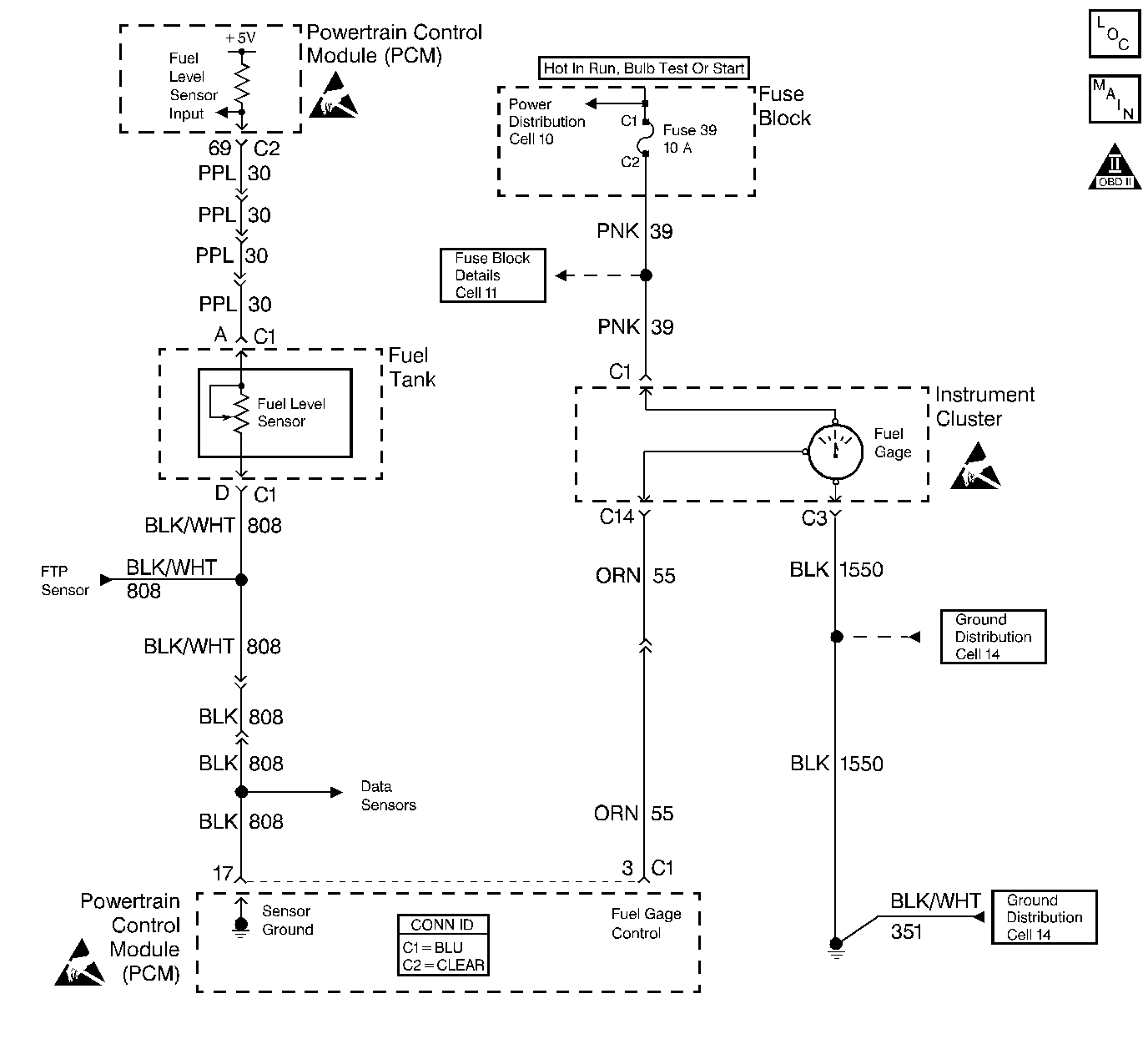
Circuit Description
Output Driver Modules (ODMs) are used by the PCM to turn on many of the current-driven devices that are needed to control various engine and Transaxle functions. ODMs have the capability of diagnosing each output circuit individually. DTC P0656 set indicates an improper voltage level on the output circuit that controls the fuel gauge.
Conditions for Running the DTC
The ignition is on.
Conditions for Setting the DTC
| • | An improper voltage level has been detected on the output circuit which controls the fuel gauge. |
| • | The above conditions are present for at least 30 seconds. |
Action Taken When the DTC Sets
| • | The PCM will not illuminate the malfunction indicator lamp (MIL). |
| • | The PCM will store conditions which were present when the DTC set as Failure Records data only. This information will not be stored as Freeze Frame data. |
Conditions for Clearing the MIL/DTC
| • | A History DTC will clear after 40 consecutive warm-up cycles have occurred without a malfunction. |
| • | The DTC can be cleared by using the scan tool Clear Info function. |
Diagnostic Aids
Check for the following conditions:
| • | Poor connection at the PCM. Inspect harness connectors for backed out terminals, improper mating, broken locks, improperly formed or damaged terminals, and poor terminal to wire connection. Refer to Intermittents and Poor Connections Diagnosis and Connector Repairs . |
| • | Damaged harness. Inspect the wiring harness for damage. Refer to Wiring Repairs . |
| • | If the harness appears to be OK, disconnect the PCM, turn the ignition on and observe a digital multimeter connected between the fuel gauge control circuit and ground at the PCM harness connector while moving connectors and wiring harnesses related to the fuel gauge. A change in voltage will indicate the location of the fault. Refer to Wiring Repairs . |
Reviewing the Fail Records vehicle mileage since the diagnostic test last failed may help determine how often the condition that caused the DTC to be set occurs. This may assist in diagnosing the condition.
Test Description
Number(s) below refer to the step number(s) on the Diagnostic Table:
-
Normally, ignition feed voltage should be present on the output control circuit with the PCM disconnected and the ignition turned on.
-
Checks for a shorted component or a short to battery positive voltage on the output control circuit. Either condition would result in a measured current of over 1.5 amps. Also checks for a component that is going open while being operated, resulting in a measured current of 0 amps.
-
Checks for a malfunctioning instrument cluster.
-
This vehicle is equipped with a PCM which utilizes an Electrically Erasable Programmable Read Only Memory (EEPROM). When the PCM is being replaced, the new PCM must be programmed.
Step | Action | Value(s) | Yes | No |
|---|---|---|---|---|
1 | Was the Powertrain OBD System Check performed? | -- | ||
2 | Was the Instrument Cluster System check in Electrical Diagnosis performed? | -- | ||
Is the voltage near the specified value? | B+ | |||
Does the current reading remain between the specified values? | 0.05 Amp-1.5 Amps | |||
Is the voltage at the specified value? | 0.0V | |||
6 | Locate and repair the short to voltage in the affected PCM output circuit. Refer to Wiring Repairs . Is the action complete? | -- | -- | |
7 | Test the ignition feed fuse for the instrument panel cluster. Is the fuse blown? | -- | ||
8 |
Is the action complete? | -- | -- | |
9 |
Is the voltage near the specified value? | B+ | ||
10 |
Was a problem found? | -- | ||
11 |
Was a problem found? | -- | ||
12 |
Does the fuel gauge indicate EMPTY? | -- | Refer to Diagnostic Aids | |
13 |
Was a problem found? | -- | ||
14 | Locate and repair open in the ignition feed circuit to the instrument panel cluster indicator lamps. Refer to Wiring Repairs . Is the action complete? | -- | -- | |
15 | Replace the instrument panel cluster. Refer to Instrument Cluster Replacement . Is the action complete? | -- | -- | |
|
Important: : Replacement PCM must be programmed. Refer to Powertrain Control Module Replacement/Programming . Replace the PCM. Is the action complete? | -- | -- | ||
17 | Operate the affected lamp using the scan tool output tests function. Does the affected lamp operate properly? | -- | System OK |
